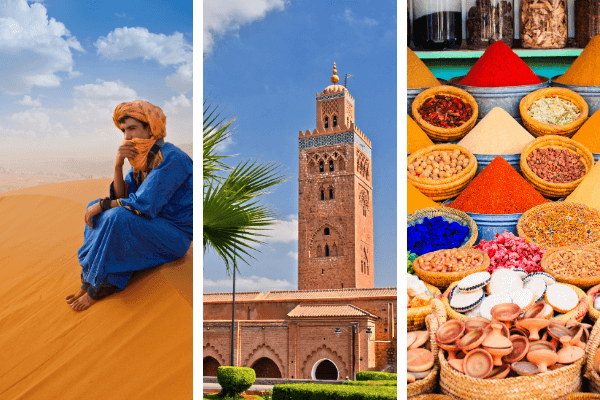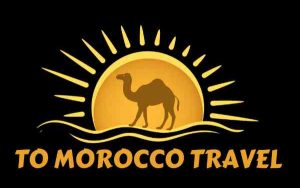
About Morocco Country
Geography of Morocco
Morocco is located in North Africa, between the Atlantic Ocean and the Mediterranean Sea. It has land boundaries with Algeria to the east and the disputed territory of Western Sahara to the south. The country’s landscape is varied, with mountain ranges like the Atlas and Rif, as well as wide swaths of sand in the Sahara.
People Ethnic groups
Morocco is primarily made up of Arabs and Imazighen, or a mix of the two. A sizable number of Imazighen live primarily in the country’s mountainous regions, which provide them with long stretches of refuge where they can preserve their language and culture. Some of the population is descended from Spanish refugees who fled the Reconquista, the Christian reconquest of the Iberian Peninsula in the 15th century. Sub-Saharan Africans were brought to Morocco by trade and slavery, and their descendants now live primarily in the southern oases and larger cities.
Moroccan Language
Two-thirds of Moroccans speak Arabic, one of the country’s national and official languages, and Modern Standard Arabic is taught in schools. Tamazight, the Amazigh language, was designated as an official language in 2011. It has been preserved in Amazigh enclaves and is spoken by approximately one-third of the population. Tamazight is taught in schools and is spoken by many Imazighen. Spanish is widely spoken, and French is an important secondary language. English is also becoming more popular.
Tamazight-speaking residents are divided into three ethnolinguistic groups: the Rif people (also known as Riffi or Riffians) of the Rif Mountains, the Middle Atlas people, and the High Atlas and Sous valley people. While there are differences between these dialects, they are all mutually understandable.
Moroccan Religion
Islam is the official state religion, and the vast majority of Moroccans follow the Mlik rite of Sunni Islam. The Alawite dynasty has ruled since the 17th century, claiming legitimacy through descent from the Prophet Muhammad. Moroccan Muslims revere the royal family because of its prophetic lineage. Sufism, like many Islamic countries, has adherents, and forms of popular religion, such as saint veneration and tomb visits, are widely practiced. Moroccan law guarantees religious freedom, but the country is home to few non-Muslims. The country has no indigenous Christian population, and its Jewish community has shrunk to a few thousand people.
Moroccan Brief History
Morocco’s history is rich and complicated, dating back to ancient times. During the Ancient and Classical periods, the region was home to Berber tribes. It eventually became part of the Roman Empire.
• In the 7th century, Arab Muslims conquered the region, introducing Islam and founding kingdoms such as the Idrisids.
Morocco’s great dynasties, including the Almoravids, Almohads, and Merinids, stretched their dominance across North Africa and Spain during the Medieval Period.
• During the 20th century, Morocco became a protectorate of France and Spain. It became independent in 1956, under King Mohammed V.
Moroccan Culture
Morocco’s culture is a fusion of Berber, Arab, and French elements, as seen in its language, architecture, cuisine, and traditions.
• Arabic and Berber are the official languages, however French is commonly used in commerce and administration.
• Moroccan cuisine features couscous, tagine, and pastilla. Spices like saffron, cumin, and cinnamon are widely utilized.
• Important cultural events include the Fez Festival of World Sacred Music, Marrakech International Film Festival, and Tan-Tan’s Moussem, a traditional Berber festival.
Moroccan Economy
Morocco’s economy is broad, with significant sectors including agriculture, mining, manufacturing, and tourism.
• Key agricultural products include citrus fruits, olives, and grapes.
• Mining: The country is a top producer of phosphate.
• Manufacturing encompasses textiles, apparel, and automobile parts.
• Tourism is a crucial industry in Morocco, with popular destinations including the medinas of Fez and Marrakech, the Sahara Desert, and seaside ports like Essaouira and Agadir.
Moroccan Tourism
Morocco is a renowned tourist destination known for its medieval cities, busy markets, and breathtaking scenery. Popular sites include: • Marrakech, known for its medina, souks, and the famous Koutoubia Mosque.
• Fez boasts one of the world’s oldest colleges, Al-Qarawiyyin, and a well-preserved medieval medina.
• Casablanca is known for its modern architecture and the majestic Hassan II Mosque.
• Chefchaouen is a lovely village in the Rif Mountains, famed for its blue-painted buildings.
• Sahara Desert: Offering experiences like camel trekking and camping in Berber tents.
Discovering Morocco: A Journey Through Time and Culture
Traveling to Morocco is like stepping into a vivid tapestry of history, culture, and natural beauty. Morocco provides an exceptional experience for all types of travelers, from the busy souks of Marrakech to the calm dunes of the Sahara. Here’s a guide to help you get the most out of your Moroccan experience.
Marrakech: The Red City.
Marrakech, also known as the Red City because of its characteristic terracotta structures, is a sensory delight. Begin your Marrakech sightseeing in Jemaa el-Fnaa, the city’s largest square, where you can enjoy the colorful atmosphere of snake charmers, musicians, and food booths. Don’t miss out on exploring the souks, which sell everything from spices to traditional Moroccan rugs.
Must-see attractions in Marrakech
• Koutoubia Mosque, which boasts breathtaking architecture.
• Visit Bahia Palace, a 19th-century palace with stunning gardens and intricately designed rooms.
• Relax at Majorelle Garden, originally owned by Yves Saint Laurent.
Fes: The Spiritual Heart.
Fes is recognized as Morocco’s cultural and spiritual center. Its ancient medina is a UNESCO World Heritage site, with narrow alleys, antique madrasas, and thriving markets. Take a guided tour to truly appreciate the city’s rich history and lively culture.
Must-see attractions in Fes
• Al Quaraouiyine institution, the world’s oldest continually operational institution.
• Chouara Tannery showcases centuries-old leather dying techniques.
• Bou Inania Madrasa, a 14th-century Islamic school, features beautiful tilework and wood carvings.
The Sahara Desert: An Ocean of Sand.
A journey to Morocco isn’t complete without visiting the beautiful Sahara Desert. Begin your desert trip in Merzouga, where you may take a camel trek to see the spectacular sunset over the dunes. Spend the night in a typical Berber camp, where you may listen to native music and eat under the stars.
Chefchaouen - The Blue Pearl
Chefchaouen, located in the Rif Mountains, is known for its blue-washed houses and breathtaking mountain views. This lovely village has a slower pace, ideal for leisurely strolls and soaking up the tranquil environment. Don’t miss out on sampling the local goat cheese and visiting the artisan stores that sell one-of-a-kind goods.
Moroccan cuisine: A culinary journey.
Moroccan cuisine is a delicious combination of flavors and spices that reflects the country’s numerous cultural influences. Enjoy traditional foods such as tagine, couscous, and pastilla. Don’t pass up the opportunity to taste Moroccan mint tea, a sign of friendliness.
Top Moroccan Dishes To Try:
• Tagine is a slow-cooked stew containing meat, vegetables, and other spices.
• Steamed semolina grains are commonly served with meat and veggies.
• Pastilla is a sweet and delicious pie filled with thin pastry, pigeon or chicken, and almonds
Good to know before traveling to Morocco
Traveling to Morocco can be an interesting and enriching experience. Here are some important recommendations and things to know before you travel.
1. Visa requirements
Check if you need a visa to enter Morocco. Many nations, including those from the United States, the European Union, Canada, and Australia, are allowed to enter Morocco without a visa for up to 90 days.
2. Currency:
The Moroccan Dirham (MAD). Credit cards are accepted in major cities and tourist destinations, but cash is recommended for smaller towns and markets. ATMs are readily available and can be used to withdraw local currency as needed.
3. Language
Arabic is the official language, while French is frequently spoken, especially in commerce and tourism. While English is commonly spoken in tourist areas, knowing a few basic words in Arabic or French can be beneficial.
4. Cultural Sensitivity
Morocco is a Muslim-majority country, so dress modestly, particularly in rural regions. During Ramadan, women should cover their shoulders and knees and show respect for fasting rituals. It is not permitted to eat, drink, or smoke in public during the daytime.
5. Transportation
Morocco has a comprehensive public transportation system that includes trains, buses, and taxis. Trains provide a simple way to travel between large cities.
If the taxi does not have a meter, use registered taxis and negotiate the fee before beginning the journey.
6. Accommodations
Morocco offers a diverse selection of housing alternatives, including luxury hotels, riads (traditional Moroccan dwellings), and inexpensive hostels.
Book in advance, especially during peak tourist seasons.
7. Shopping and Bargaining
Markets (souks) are plentiful and colorful. Bargaining is a widespread activity, so don’t be scared to haggle for a better deal.
Demonstrate respect and politeness throughout discussions.
8. Food and Drink
Moroccan cuisine is varied and tasty. For traditional foods, try tagine, couscous, and pastilla. While street food is generally safe, it’s important to find sellers with appropriate cleanliness measures.
9. Internet and Connectivity
Wi-Fi is frequently available in hotels, cafes, and restaurants in cities.
Purchase a local SIM card for reliable internet connection.
Contact Us For Any Inquiries
